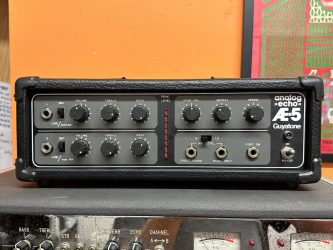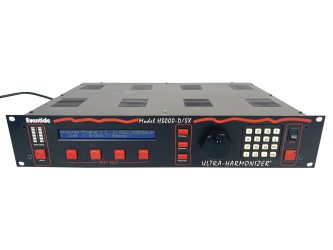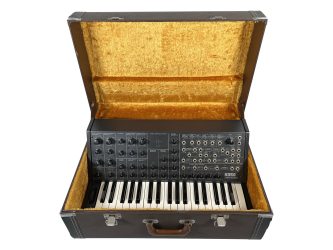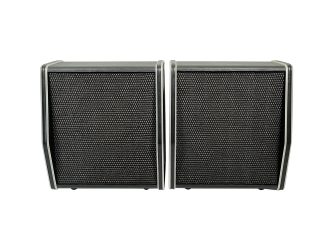Product
EMS Synthi Hi-Fli / (HiFli)
Brand: ems
Categories: Effects Pedals, Other Processors, Processors & Effects, Synthesizers, Synths & Drum Machines
The ultimate in vintage tone and vibe: this just oozes the sort of early 70s David Gilmour sounds as heard on Dark Side Of The Moon.
PRODUCT DESCRIPTION
The ultimate in vintage tone and vibe: this just oozes the sort of early 70s David Gilmour sounds as heard on Dark Side Of The Moon.
Will be shipped following a full overhaul by EMS Cornwall. The estimated shipping time is 2-3 months.
Description
EMS Synthi Hi-Fli for sale complete with double foot pedal.
This was found, covered in a couple of decades’ dust with no knobs or sliders. But when we opened it up to see what was smashed up inside it turned out the noise was a neat bag of all the missing hardware. It was also all original and in clean condition internally, so once this has been restored by EMS Cornwall it’s gong to be a superb example.
Why Hi-Fli?
Number one in Analogman Tom’s list of rare guitar effects from his excellent book.
Features heavily in Tony’s Monster Mutilators Article for Premier Guitar.
Used by David Gilmour – see this Gilmourish blog for further details – he bought a prototype in 1972 and from what he recalls it was “very, very expensive”; Gilmourish suggest it was used during the recording of Dark Side Of The Moon though DG’s long time tech, Phil Taylor, told us he thinks it wasn’t.
In a way it is immaterial whether or not it was used on DSOTM: the Hi-Fli is your route to creating Gilmour style sounds and effects – nothing else sounds quite like it. I’d keep mine just for the two phaser and three vocal wah settings called Waa, Waw and Meow. And it’s not just for guitarists – running keys/synths and drum machines through it can be a shortcut to vintage sonic nirvana.
Designed by David Cockerell in 1971 for EMS: with only 350 units originally produced, the Hi-Fli was actually referred to as a synthesizer in the original ad, but it’s basically an analog multi-effect processor, which can be used on vocals, guitars, organs, synths etc. It has two footpedals, which could be routed as control voltages/expression pedal to any of the slider functions. It’s got no memory to bank up settings, – everything is in real-time, so one had to manually tweak the sliders for each tone change. You’ll suddenly hit upon an amazing combination while tweaking the knobs – be sure to hit record as repeating it can prove elusive.
Product photos include a shot of David in his home studio in 1972 with a prototype of the Hi-Fli.
HiFli Controls:
Top Boost: Provides up to 30 db treble boost.
Octave Shift: Drops the pitch by an octave.
Buzz Switch: Adds high frequencies overtones to the sub-octave signal.
Ring Mod: Produce an octave higher when a single note is played and the typical ring modulation when two or more strings are played.
Decay Rate: A rotary control controls the decay time of the ring mod and octave shift signal level.
Sustain Fuzz: Special circuits detect the beginning and end of each note and apply upper harmonics.
Attack Rate: A rotary control varies the rise time of Sustained Fuzz signal. Notes can be sustained even though the original signal has dropped by more than 20db.
Pedal Switches: The switches under the sliders combine the pedal control with the manual sliders. Selections of switches with pre-set slider positions enable the pedal to change treatments instantly.
Solo/Strum: This switch alters the Hi-Fli’s sensitivity to signal attacks and should be set to more sensitive for single notes (i.e solo).
Bypass Mix Fader: This central slider controls the mix of the original and treated sound. In the high position only the input pre-amplifier is in-circuit. The bypass footswitch gives instant access to this position. The output from the Octave shitft, Ring Modulator and Fuzz Sustain sections are re-combined and go to the phase filter and modulator section.
Control Modulation Selector: 6 position control knob.
Treatment Selector: There are six distinct modes of operation – Vibrato, two modes of Phasing, normal WAA-WAA (1 resonant peak), WAW-WAW (six resonant peaks) a completely new sound, and finally MEOW (two sets of three resonant peaks moving in oppisite directions.
Modulation Speed: This slider operates in the first 4 positions of the control modulation selector, providing a fine frequency control.
Modulation Ramp Time: Operates in positions 3 to 6 of the conrol modulation selector.
Modulation Depth: Controls the depth of the Phaser.
Frequency shift: This controls the frequency domain in which the modulation waveform operates, being central for symmetrical modulation.
L.E.D selectors: Two light emitting diodes show the movement of the modulation waveform.
“AnalogMan’s Guide to Vintage Effects” by Tom Hughes
and the David Gilmour Gear Forum.
Condition
In very good cosmetic condition with minor scratches on the face. The case is very good with some dings and signs of wear. Please see photos or get in touch if you require more information on condition.
Voltage Information
220/240v unit. A step-up transformer will be required for use on 110/120v supplies. Please ask if you need advice on what to use. We do not recommend using cheap, generic Chinese mains transformers.
Tax
Zero rated for VAT.
Video Demos
DIG DEEPER...

Gear feature
Gear History
EMS Synthi Hi-Fli
Tony goes deep into the Synthi HiFli - history, some of the ways it can be used, and the different versions we've had through the studio...
PUBLISHED: 2nd Oct 2018

Machines With Soul
Not a another guide to Synthi AKS, but an account of my experience encountering and using one of these remarkable instruments.
PUBLISHED: 17th Jul 2018

TESTIMONIALS
RECENT BLOG ARTICLES

The Weird and the Wonderful – An Auction Update
We can't stop here, this is bat country! Our next auction (November 22nd) features some head-turning, show-stopping synths, however we also wanted to put the spotlight...
PUBLISHED: 21st Nov 2023

Teaching Machines Wellspring Reverb Review
Tony takes a dive into the new Welsh-made Wellspring Stereo Reverb and comes up with a very big smile on his face.
PUBLISHED: 17th Oct 2023
OUR GUARANTEE
We stand behind our gear with a guarantee of your satisfaction - see the FAQ section above for full details and buy with complete confidence.
SHIPPING DISCOUNTS
When buying more than one item you only pay the shipping on the item with the highest shipping cost. Calculated automatically at checkout.
NEED HELP?
Get in touch via the contact page. We know & love our gear and we want to ensure you get something that matches your needs (that, and we just like talking gear).






























